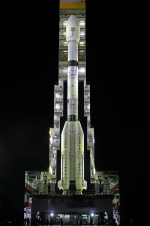Indian Space Program: News & Discussions
- Thread starter Tarun
- Start date
-
- Tags
- isro
You are using an out of date browser. It may not display this or other websites correctly.
You should upgrade or use an alternative browser.
You should upgrade or use an alternative browser.
Massive expansion of capabilities coming:
India planning to launch 50 satellites for intelligence gathering in five years: ISRO chief
Many satellites are being designed and configured, he said.
07:56 am IST, Updated 10:31 am IST
December 29, 2023
By PTI, Mumbai.

Spacecraft EOS-04 (previously designated as RISAT-1A) atop launch vehicle before encapsulation. Credit: ISRO.
India is aiming to launch 50 satellites in the next five years for geo-intelligence gathering which will include the creation of a layer of satellites in different orbits with a capacity to track the movement of troops and image thousands of kilometres of area, Indian Space Research Organisation (ISRO) chairman S. Somanath said here on December 28.
For realising India's aspiration to become a strong nation, the current size of its satellite fleet is not enough and it should be "ten times what we have today", he said, speaking at `Techfest', an annual science and technology event organised by the Indian Institute of Technology Bombay here.
It was important to improve the ability of satellites to detect changes, to bring in more of AI-related and data-driven approach to analyse data, reduce data downloads and get only the necessary information, he said.
Spacecrafts are capable of observing a country's borders and neighbouring regions, the ISRO chief noted.
"All of it can be seen from satellites. This capability gives us enormous potential. We have been launching satellites to handle this, but there is a different way of thinking now and we need to look at it in a much more critical manner because the power of (any) nation is the ability to understand what is happening around it," Mr. Somanath said.
Many satellites are being designed and configured, he said. "We have already configured 50 satellites to be realised in the next five years and this is going to be launched for India for supporting this particular geo-intelligence capability over the next five years plus (period)," the ISRO chief added.
If India is able to launch satellites at this scale, threats to the country can be better mitigated, Mr. Somanath said.

GISAT-1 is a military imaging satellite with a high temporal resolution, meant for providing near real time imaging with fast revisit capability and real time monitoring. Credit: ISRO.
"We have found out a way by which a layer of satellites can be launched starting from GEO (geostationary equatorial orbit) to LEO (lower earth orbit) and also (in) very low earth orbit where we need very critical assessment of some situation," he said.
This is a new domain which is coming up not only in optical, but also in SAR (synthetic aperture radar), thermal and various other technologies, Mr. Somanath pointed out.
"We will have communication between satellites, so that if some satellite detects something, which is at GEO at 36,000 kms, it can have a large view. If you find some activity happening, you can task another satellite in the lower orbit (to check) much more carefully and then give more information," he said.
"We are also looking at imaging, not a very small area (but) thousands of kilometers of area and we would like to cover entire borders in everyday cycles. This is a tremendous capability that we are building if we are able to launch these satellites in the next five years," he said.
Mr. Somanath noted that the overall satellite fleet of the country, with its current strength of 54, is "just not enough" for a nation like India which is aspiring to be powerful and strong.
"I think it must be ten times what we have today," the ISRO chief said.
India planning to launch 50 satellites for intelligence gathering in five years: ISRO chief
India planning to launch 50 satellites for intelligence gathering in five years: ISRO chief
Many satellites are being designed and configured, he said.
07:56 am IST, Updated 10:31 am IST
December 29, 2023
By PTI, Mumbai.

Spacecraft EOS-04 (previously designated as RISAT-1A) atop launch vehicle before encapsulation. Credit: ISRO.
India is aiming to launch 50 satellites in the next five years for geo-intelligence gathering which will include the creation of a layer of satellites in different orbits with a capacity to track the movement of troops and image thousands of kilometres of area, Indian Space Research Organisation (ISRO) chairman S. Somanath said here on December 28.
For realising India's aspiration to become a strong nation, the current size of its satellite fleet is not enough and it should be "ten times what we have today", he said, speaking at `Techfest', an annual science and technology event organised by the Indian Institute of Technology Bombay here.
It was important to improve the ability of satellites to detect changes, to bring in more of AI-related and data-driven approach to analyse data, reduce data downloads and get only the necessary information, he said.
Spacecrafts are capable of observing a country's borders and neighbouring regions, the ISRO chief noted.
"All of it can be seen from satellites. This capability gives us enormous potential. We have been launching satellites to handle this, but there is a different way of thinking now and we need to look at it in a much more critical manner because the power of (any) nation is the ability to understand what is happening around it," Mr. Somanath said.
Many satellites are being designed and configured, he said. "We have already configured 50 satellites to be realised in the next five years and this is going to be launched for India for supporting this particular geo-intelligence capability over the next five years plus (period)," the ISRO chief added.
If India is able to launch satellites at this scale, threats to the country can be better mitigated, Mr. Somanath said.

GISAT-1 is a military imaging satellite with a high temporal resolution, meant for providing near real time imaging with fast revisit capability and real time monitoring. Credit: ISRO.
"We have found out a way by which a layer of satellites can be launched starting from GEO (geostationary equatorial orbit) to LEO (lower earth orbit) and also (in) very low earth orbit where we need very critical assessment of some situation," he said.
This is a new domain which is coming up not only in optical, but also in SAR (synthetic aperture radar), thermal and various other technologies, Mr. Somanath pointed out.
"We will have communication between satellites, so that if some satellite detects something, which is at GEO at 36,000 kms, it can have a large view. If you find some activity happening, you can task another satellite in the lower orbit (to check) much more carefully and then give more information," he said.
"We are also looking at imaging, not a very small area (but) thousands of kilometers of area and we would like to cover entire borders in everyday cycles. This is a tremendous capability that we are building if we are able to launch these satellites in the next five years," he said.
Mr. Somanath noted that the overall satellite fleet of the country, with its current strength of 54, is "just not enough" for a nation like India which is aspiring to be powerful and strong.
"I think it must be ten times what we have today," the ISRO chief said.
India planning to launch 50 satellites for intelligence gathering in five years: ISRO chief
INSAT-3DS Satellite Flagged off to SDSC-SHAR
January 27, 2024

INSAT-3DS, is an exclusive meteorological satellite realized by ISRO with the primary objective to provide continuity of services to the existing in-orbit INSAT-3D and 3DR satellites and significantly enhancing the capabilities of INSAT system is flagged off to SDSC-SHAR launch port on January 25, 2024 for the launch onboard GSLV F14. The Satellite had successfully completed Satellite Assembly, Integration & Testing activities at U R Rao Satellite Centre, Bengaluru. Pre-Shipment Review (PSR) was held with the participation of members from user community on January 25, 2024.
The satellite is a user funded project with Ministry of Earth Science (MoES), configured around ISRO's well proven I-2k bus platform with a Lift-Off Mass of 2275 kg. Indian Industries have significantly contributed in the making of the Satellite.
The satellite is designed for enhanced meteorological observations and monitoring of land and ocean surfaces for weather forecasting and disaster warning, with state-of-the-art payloads viz., 6 channel Imager & 19 channel Sounder meteorology payloads, communication payloads viz., The Data Relay Transponder (DRT) and Satellite aided Search and Rescue (SAS&R) transponder. The Data relay transponder (DRT) instrument, receives meteorological, hydrological and oceanographic data from automatic Data Collection Platforms / Automatic Weather Stations (AWS) and augments the weather forecasting capabilities. Satellite aided Search and Rescue (SAS&R) transponder is incorporated in the satellite to relay a distress signal / alert detection from the beacon transmitters for search and rescue services with global receive coverage.
INSAT-3DS Satellite Flagged off to SDSC-SHAR
January 27, 2024

INSAT-3DS, is an exclusive meteorological satellite realized by ISRO with the primary objective to provide continuity of services to the existing in-orbit INSAT-3D and 3DR satellites and significantly enhancing the capabilities of INSAT system is flagged off to SDSC-SHAR launch port on January 25, 2024 for the launch onboard GSLV F14. The Satellite had successfully completed Satellite Assembly, Integration & Testing activities at U R Rao Satellite Centre, Bengaluru. Pre-Shipment Review (PSR) was held with the participation of members from user community on January 25, 2024.
The satellite is a user funded project with Ministry of Earth Science (MoES), configured around ISRO's well proven I-2k bus platform with a Lift-Off Mass of 2275 kg. Indian Industries have significantly contributed in the making of the Satellite.
The satellite is designed for enhanced meteorological observations and monitoring of land and ocean surfaces for weather forecasting and disaster warning, with state-of-the-art payloads viz., 6 channel Imager & 19 channel Sounder meteorology payloads, communication payloads viz., The Data Relay Transponder (DRT) and Satellite aided Search and Rescue (SAS&R) transponder. The Data relay transponder (DRT) instrument, receives meteorological, hydrological and oceanographic data from automatic Data Collection Platforms / Automatic Weather Stations (AWS) and augments the weather forecasting capabilities. Satellite aided Search and Rescue (SAS&R) transponder is incorporated in the satellite to relay a distress signal / alert detection from the beacon transmitters for search and rescue services with global receive coverage.
INSAT-3DS Satellite Flagged off to SDSC-SHAR
INSAT-3DS Satellite Flagged off to SDSC-SHAR
January 27, 2024
View attachment 31774
INSAT-3DS, is an exclusive meteorological satellite realized by ISRO with the primary objective to provide continuity of services to the existing in-orbit INSAT-3D and 3DR satellites and significantly enhancing the capabilities of INSAT system is flagged off to SDSC-SHAR launch port on January 25, 2024 for the launch onboard GSLV F14. The Satellite had successfully completed Satellite Assembly, Integration & Testing activities at U R Rao Satellite Centre, Bengaluru. Pre-Shipment Review (PSR) was held with the participation of members from user community on January 25, 2024.
The satellite is a user funded project with Ministry of Earth Science (MoES), configured around ISRO's well proven I-2k bus platform with a Lift-Off Mass of 2275 kg. Indian Industries have significantly contributed in the making of the Satellite.
The satellite is designed for enhanced meteorological observations and monitoring of land and ocean surfaces for weather forecasting and disaster warning, with state-of-the-art payloads viz., 6 channel Imager & 19 channel Sounder meteorology payloads, communication payloads viz., The Data Relay Transponder (DRT) and Satellite aided Search and Rescue (SAS&R) transponder. The Data relay transponder (DRT) instrument, receives meteorological, hydrological and oceanographic data from automatic Data Collection Platforms / Automatic Weather Stations (AWS) and augments the weather forecasting capabilities. Satellite aided Search and Rescue (SAS&R) transponder is incorporated in the satellite to relay a distress signal / alert detection from the beacon transmitters for search and rescue services with global receive coverage.
INSAT-3DS Satellite Flagged off to SDSC-SHAR
Why satellites are covered with golden foil?
It is called multi-layer insulation (MLI). It is needed to prevent het loss from a spacecraft/satellite.Why satellites are covered with golden foil?
Multi-layer insulation - Wikipedia








































